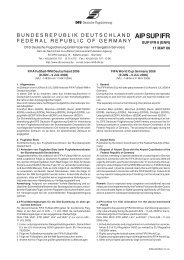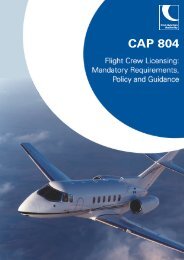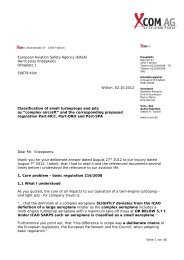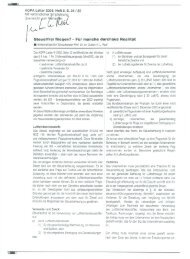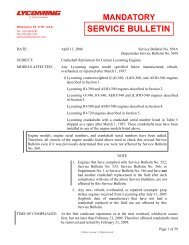The International Comanche Society - Pilot und Flugzeug
The International Comanche Society - Pilot und Flugzeug
The International Comanche Society - Pilot und Flugzeug
Create successful ePaper yourself
Turn your PDF publications into a flip-book with our unique Google optimized e-Paper software.
It means that there were some 1,300<br />
feet until the end of the runway, which<br />
is turf and was dry. Why not abort the<br />
takeoff and aggressively ride the brakes?<br />
It should have worked.<br />
I fail to <strong>und</strong>erstand the meaning of<br />
“We were past abort point”. If acceleration<br />
degrades there must be something<br />
which is wrong or very wrong (like an<br />
engine failure, fuel starvation or a rapid<br />
change in wind direction) and may<br />
become more so in a second. <strong>The</strong>refore,<br />
in most of these circumstances, aborting<br />
the takeoff would be the least hazardous<br />
action, and a fixed idea of an “abort point”<br />
may be dangerous. I still have to learn<br />
how an abort point can be determined.<br />
In this case, the aircraft climbed to 40<br />
feet while still over the runway. It could<br />
not have been too close to the end of it.<br />
<strong>The</strong> above is what I believe to be the<br />
essence of the probable cause. However,<br />
there is a secondary probable cause.<br />
This relates to soft field takeoff procedures,<br />
but is applicable to every takeoff.<br />
It is <strong>und</strong>erstood that when a pilot sees<br />
obstacles growing larger through the<br />
windshield, the instinct is to pull back<br />
on the yoke. <strong>The</strong> correct action however<br />
is to maintain level flight and let the<br />
aircraft accelerate, then “jump over” the<br />
obstacle. A <strong>Comanche</strong> with a properly<br />
operating engine and full throttle will<br />
accelerate very nicely when leveled at<br />
40 feet. We don’t know, however, whether<br />
the gear and the flaps, if deployed,<br />
were retracted.<br />
Generally speaking, before starting<br />
the takeoff run we should do some<br />
thinking as to what should be done if<br />
something possibly goes wrong. It is a<br />
moment of full concentration and<br />
attention, and some pre-evaluation<br />
may save us from a bad surprise.<br />
Likewise, before each landing the<br />
checklist and go aro<strong>und</strong> procedure<br />
should be clear, especially when <strong>und</strong>er<br />
instrument conditions. A good state of<br />
mind is to say to oneself: I am going to<br />
make an approach to the runway and<br />
then go aro<strong>und</strong>, but if conditions permit<br />
I will abort the go-aro<strong>und</strong> and land.<br />
Lessons<br />
<strong>The</strong> wind may change suddenly from<br />
one flight to the next.<br />
At every takeoff, some thinking should<br />
be given to what should be done if<br />
something goes wrong during takeoff.<br />
Proverb<br />
Remember, you’re always a student<br />
in an airplane.<br />
SEPTEMBER 2006 <strong>Comanche</strong> Flyer • 21





